2010 MITSUBISHI L200 trailer
[x] Cancel search: trailerPage 126 of 369
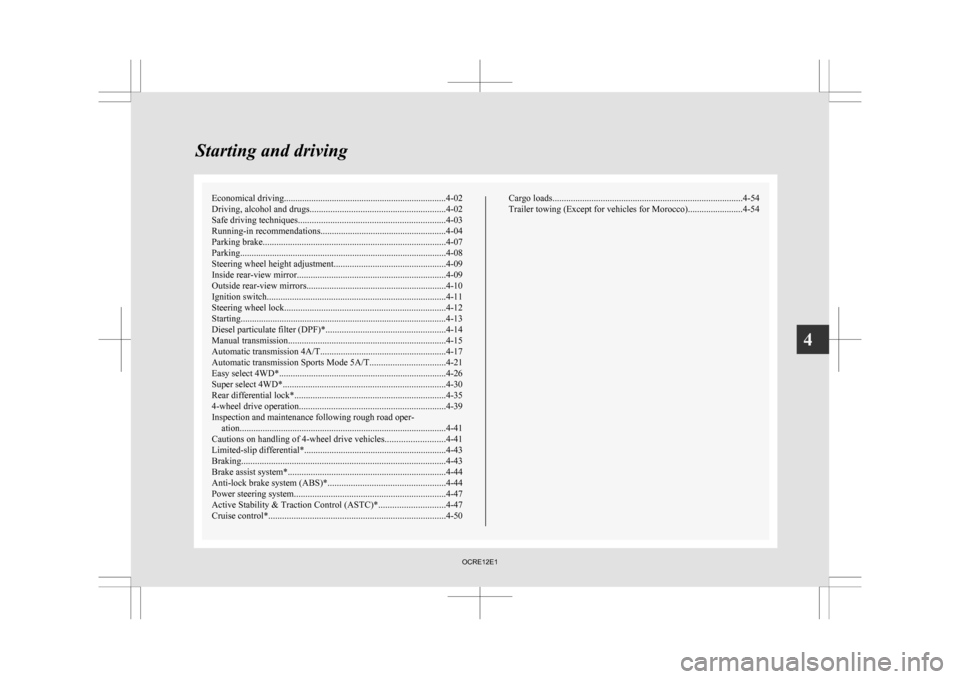
Economical driving.......................................................................4-02
Driving, alcohol and drugs
........................................................... 4-02
Safe driving techniques ................................................................ 4-03
Running-in recommendations
.......................................................4-04
Parking brake................................................................................ 4-07
Parking.......................................................................................... 4-08
Steering wheel height adjustment .................................................4-09
Inside rear-view mirror ................................................................. 4-09
Outside rear-view mirrors ............................................................. 4-10
Ignition switch .............................................................................. 4-11
Steering wheel lock ...................................................................... 4-12
Starting..........................................................................................4-13
Diesel particulate filter (DPF)* .................................................... 4-14
Manual transmission ..................................................................... 4-15
Automatic transmission 4A/T....................................................... 4-17
Automatic transmission Sports Mode 5A/T .................................4-21
Easy select 4WD* ......................................................................... 4-26
Super select 4WD* ....................................................................... 4-30
Rear differential lock* .................................................................. 4-35
4-wheel drive operation ................................................................ 4-39
Inspection and maintenance following rough road oper- ation.......................................................................................... 4-41
Cautions on handling of 4-wheel drive vehicles ..........................4-41
Limited-slip differential* .............................................................. 4-43
Braking......................................................................................... 4-43
Brake assist system*..................................................................... 4-44
Anti-lock brake system (ABS)* ................................................... 4-44
Power steering system.................................................................. 4-47
Active Stability & Traction Control (ASTC)* .............................4-47
Cruise control* ............................................................................. 4-50 Cargo loads...................................................................................
4-54
Trailer towing (Except for vehicles for Morocco) ........................4-54Starting and driving
4
OCRE12E1
Page 129 of 369
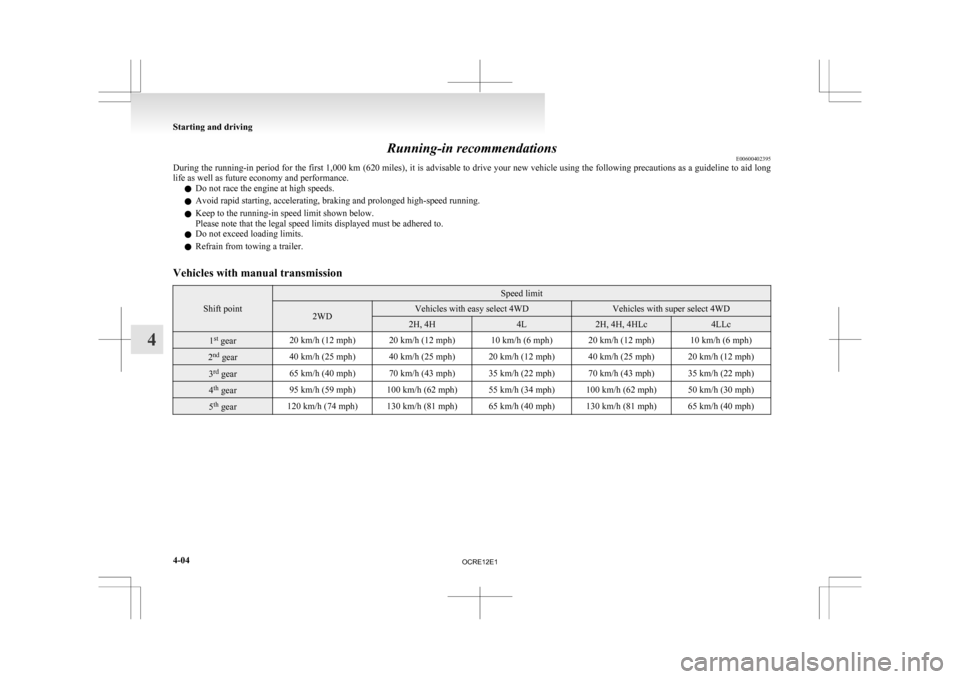
Running-in recommendations
E00600402395
During
the running-in period for the first 1,000 km (620 miles), it is advisable to drive your new vehicle using the following precautions as a guideline to aid long
life as well as future economy and performance.
l Do not race the engine at high speeds.
l Avoid rapid starting, accelerating, braking and prolonged high-speed running.
l Keep to the running-in speed limit shown below.
Please note that the legal speed limits displayed must be adhered to.
l Do not exceed loading limits.
l Refrain from towing a trailer.
Vehicles with manual transmission Shift point Speed limit
2WD Vehicles with easy select 4WD Vehicles with super select 4WD
2H, 4H 4L 2H, 4H, 4HLc 4LLc
1
st
gear 20 km/h (12 mph) 20 km/h (12 mph) 10 km/h (6 mph) 20 km/h (12 mph) 10 km/h (6 mph)2
nd
gear 40 km/h (25 mph) 40 km/h (25 mph) 20 km/h (12 mph) 40 km/h (25 mph) 20 km/h (12 mph)3
rd
gear 65 km/h (40 mph) 70 km/h (43 mph) 35 km/h (22 mph) 70 km/h (43 mph) 35 km/h (22 mph)4
th
gear 95 km/h (59 mph) 100 km/h (62 mph) 55 km/h (34 mph) 100 km/h (62 mph) 50 km/h (30 mph)5
th
gear 120 km/h (74 mph) 130 km/h (81 mph) 65 km/h (40 mph) 130 km/h (81 mph) 65 km/h (40 mph)Starting and driving
4-04
4
OCRE12E1
Page 179 of 369

Cargo loads
E00609901123
Cargo loads precautions CAUTION
l
When loading luggage, be careful to the
following. • Stow cargo and luggage in the cargoarea whenever possible.
• Distribute cargo or luggage evenly not to be unbalanced in weight.
• Do not place cargo or luggage on the instrument panel.
Also, do not stack up cargo or luggage
on the front passenger’s seat or the
rear seat.
Having the driver’s vision blocked,
and your cargo being thrown inside
the cabin if you suddenly have to
brake can cause a serious accident or
injury. Trailer towing (Except for
vehicles for Morocco) E00610000521
In
order to tow a trailer with your vehicle, when hav-
ing a trailer towing device mounted that meets all
relevant regulations in your area, consult a
MITSUBISHI MOTORS Authorized Service Point.
The regulations concerning the towing of a trailer
may differ from country to country. You are ad-
vised to obey the regulations in each area. CAUTION
l
Danger of Accident!
A
towing bar should be fitted according
to MITSUBISHI MOTORS guidelines.
NOTE l If
you are going to tow a trailer, pay careful
attention to the following points.
Maximum towable weight with brake
and maximum trailer-nose weight
Never exceed the maximum towable weight with
brake and the maximum trailer-nose weight as lis-
ted in the specifications. (Refer to “Vehicle
weight” on page 9-10.)
If you tow a trailer at an altitude of more than
1,000 m above sea-level, reduce your weight by
10 % of the gross combination weight for every in-
crease of 1,000 m above sea-level, as the engine out-
put is lowered owing to decrease in atmospheric
pressure. Towing bar mounting specifications
See
the following table for fixing points (A) for the
towing bar.
Club cab Starting and driving
4-54
4
OCRE12E1
Page 181 of 369
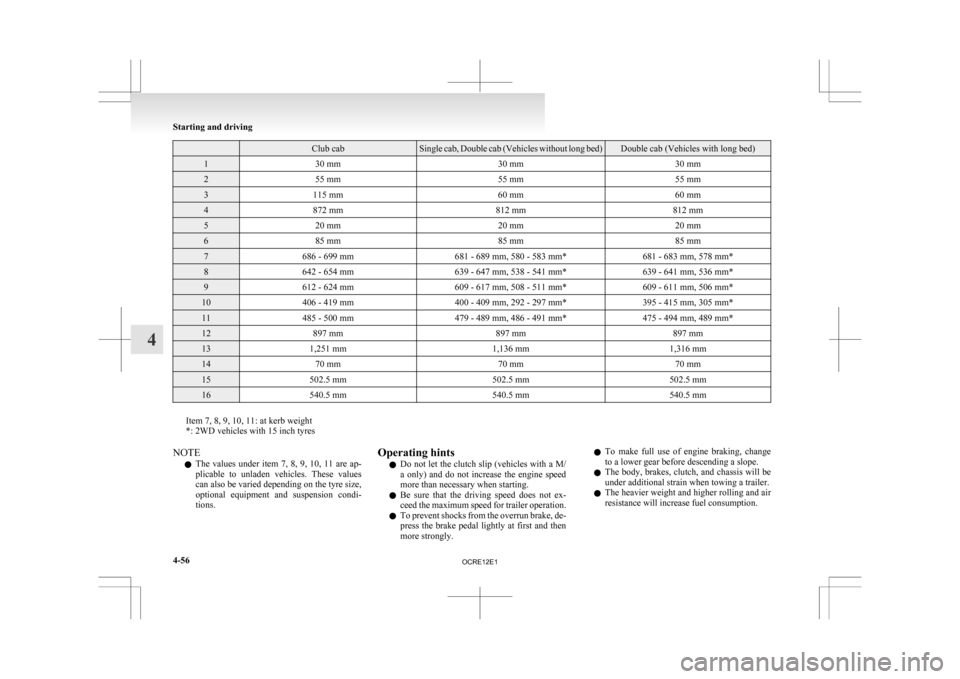
Club cab Single cab, Double cab (Vehicles without long bed) Double cab (Vehicles with long bed)
1
30 mm 30 mm30 mm2
55 mm 55 mm55 mm3
115 mm 60 mm60 mm4
872 mm 812 mm812 mm5
20 mm 20 mm20 mm6
85 mm 85 mm85 mm7
686 - 699 mm 681 - 689 mm, 580 - 583 mm* 681 - 683 mm, 578 mm*8
642 - 654 mm 639 - 647 mm, 538 - 541 mm* 639 - 641 mm, 536 mm*9
612 - 624 mm 609 - 617 mm, 508 - 511 mm* 609 - 611 mm, 506 mm*10
406 - 419 mm 400 - 409 mm, 292 - 297 mm* 395 - 415 mm, 305 mm*11
485 - 500 mm 479 - 489 mm, 486 - 491 mm* 475 - 494 mm, 489 mm*12
897 mm 897 mm897 mm13
1,251 mm 1,136 mm1,316 mm14
70 mm 70 mm70 mm15
502.5 mm 502.5 mm502.5 mm16
540.5 mm 540.5 mm540.5 mmItem 7, 8, 9, 10, 11: at kerb weight
*: 2WD vehicles with 15 inch tyres
NOTE
l The
values under item 7, 8, 9, 10, 11 are ap-
plicable to unladen vehicles. These values
can also be varied depending on the tyre size,
optional equipment and suspension condi-
tions. Operating hints
l Do
not let the clutch slip (vehicles with a M/
a only) and do not increase the engine speed
more than necessary when starting.
l Be sure that the driving speed does not ex-
ceed the maximum speed for trailer operation.
l To prevent shocks from the overrun brake, de-
press the brake pedal lightly at first and then
more strongly. l
To make full use of engine braking, change
to a lower gear before descending a slope.
l The body, brakes, clutch, and chassis will be
under additional strain when towing a trailer.
l The heavier weight and higher rolling and air
resistance will increase fuel consumption. Starting and driving
4-56
4
OCRE12E1
Page 309 of 369
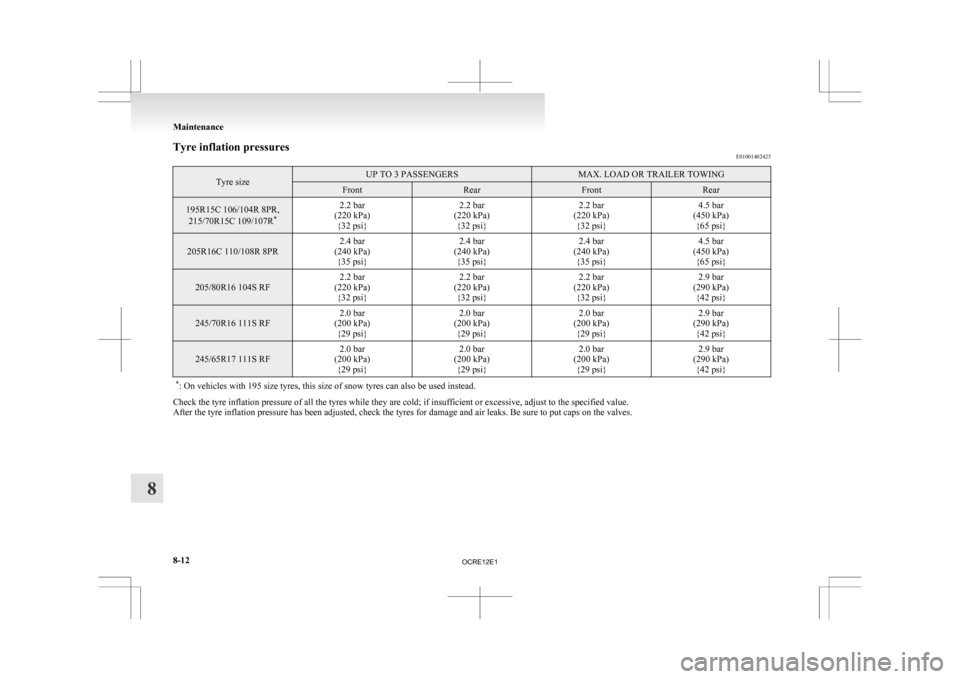
Tyre inflation pressures
E01001402423Tyre size UP TO 3 PASSENGERS MAX. LOAD OR TRAILER TOWING
Front Rear Front Rear
195R15C 106/104R 8PR,
215/70R15C 109/107R *2.2 bar
(220 kPa) {32 psi} 2.2 bar
(220 kPa) {32 psi} 2.2 bar
(220 kPa) {32 psi} 4.5 bar
(450 kPa) {65 psi} 205R16C 110/108R 8PR
2.4 bar
(240 kPa) {35 psi} 2.4 bar
(240 kPa) {35 psi} 2.4 bar
(240 kPa) {35 psi} 4.5 bar
(450 kPa) {65 psi} 205/80R16 104S RF
2.2 bar
(220 kPa) {32 psi} 2.2 bar
(220 kPa) {32 psi} 2.2 bar
(220 kPa) {32 psi} 2.9 bar
(290 kPa) {42 psi} 245/70R16 111S RF
2.0 bar
(200 kPa) {29 psi} 2.0 bar
(200 kPa) {29 psi} 2.0 bar
(200 kPa) {29 psi} 2.9 bar
(290 kPa) {42 psi} 245/65R17 111S RF
2.0 bar
(200 kPa) {29 psi} 2.0 bar
(200 kPa) {29 psi} 2.0 bar
(200 kPa) {29 psi} 2.9 bar
(290 kPa) {42 psi}
* : On vehicles with 195 size tyres, this size of snow tyres can also be used instead. Check the tyre inflation pressure of all the tyres while they are cold; if insufficient or excessive, adjust to the specified value.
After the tyre inflation pressure has been adjusted, check the tyres for damage and air leaks. Be sure to put caps on the valves.Maintenance
8-12
8
OCRE12E1
Page 341 of 369
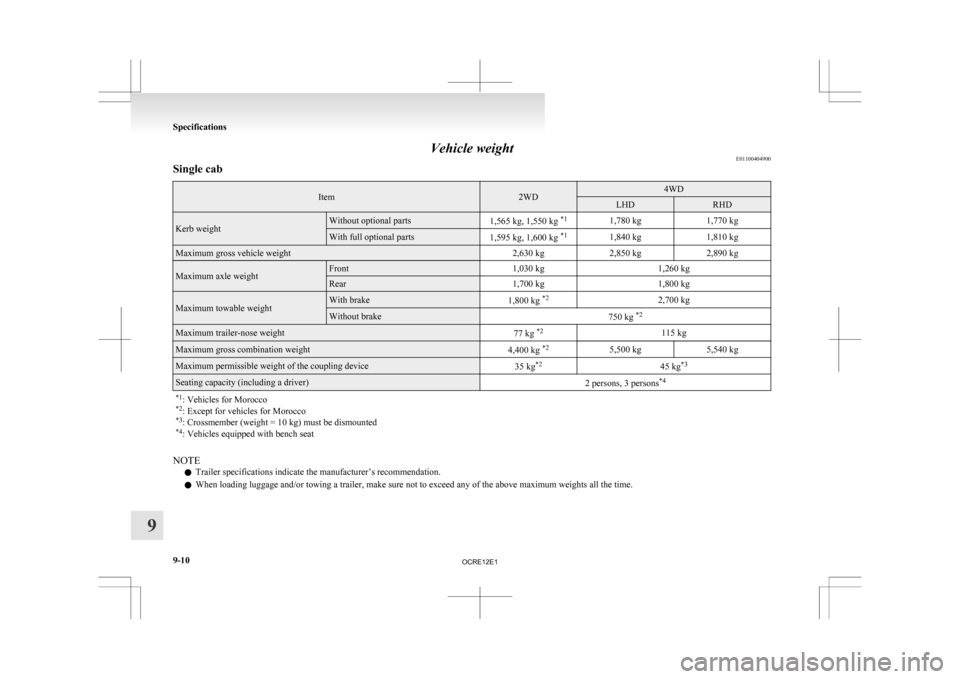
Vehicle weight
E01100404900
Single cab Item 2WD 4WD
LHD RHD
Kerb weight Without optional parts
1,565 kg, 1,550 kg *1
1,780 kg 1,770 kg With full optional parts
1,595 kg, 1,600 kg *1
1,840 kg 1,810 kgMaximum gross vehicle weight
2,630 kg2,850 kg2,890 kgMaximum axle weight Front
1,030 kg1,260 kg Rear
1,700 kg1,800 kgMaximum towable weight With brake
1,800 kg *2
2,700 kg Without brake
750 kg *2 Maximum trailer-nose weight
77 kg *2
115 kgMaximum gross combination weight
4,400 kg *2
5,500 kg 5,540 kgMaximum permissible weight of the coupling device
35 kg*2
45 kg*3 Seating capacity (including a driver)
2 persons, 3 persons*4
*1 : Vehicles for Morocco
*2 : Except for vehicles for Morocco
*3 : Crossmember (weight = 10 kg) must be dismounted
*4 : Vehicles equipped with bench seat NOTE
l Trailer specifications indicate the manufacturer’s recommendation.
l When loading luggage and/or towing a trailer, make sure not to exceed any of the above maximum weights all the time. Specifications
9-10
9
OCRE12E1
Page 342 of 369
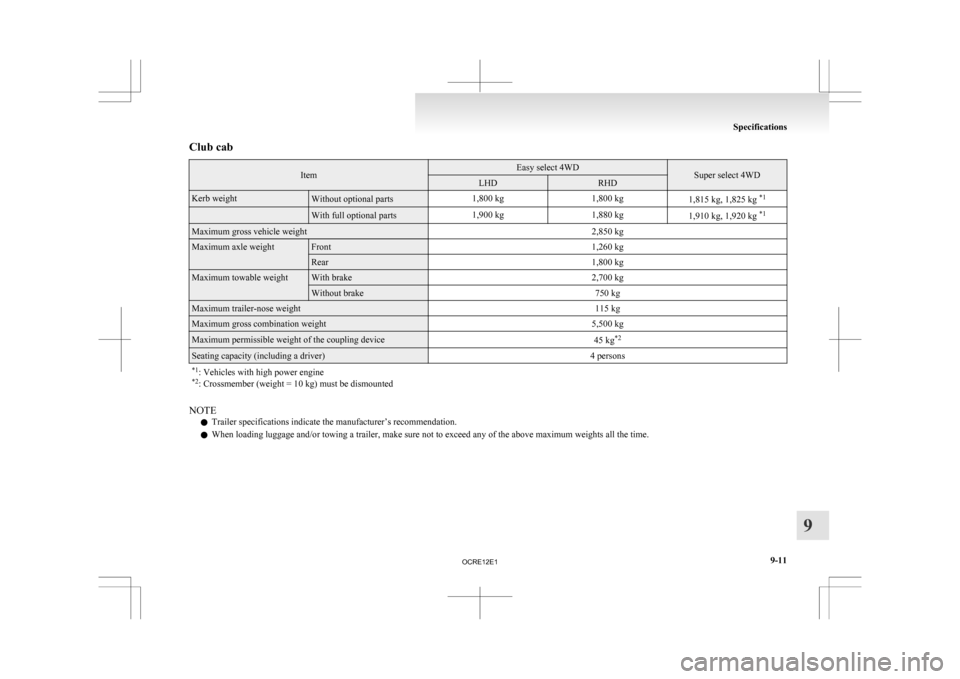
Club cab
Item Easy select 4WD
Super select 4WD
LHD RHD
Kerb weight
Without optional parts
1,800 kg
1,800 kg
1,815 kg, 1,825 kg *1
With full optional parts
1,900 kg
1,880 kg
1,910 kg, 1,920 kg *1Maximum gross vehicle weight
2,850 kgMaximum axle weight Front
1,260 kgRear
1,800 kgMaximum towable weight With brake
2,700 kgWithout brake
750 kgMaximum trailer-nose weight
115 kgMaximum gross combination weight
5,500 kgMaximum permissible weight of the coupling device
45 kg*2 Seating capacity (including a driver)
4 persons
*1 : Vehicles with high power engine
*2 : Crossmember (weight = 10 kg) must be dismounted NOTE
l Trailer specifications indicate the manufacturer’s recommendation.
l When loading luggage and/or towing a trailer, make sure not to exceed any of the above maximum weights all the time. Specifications
9-11 9
OCRE12E1
Page 343 of 369
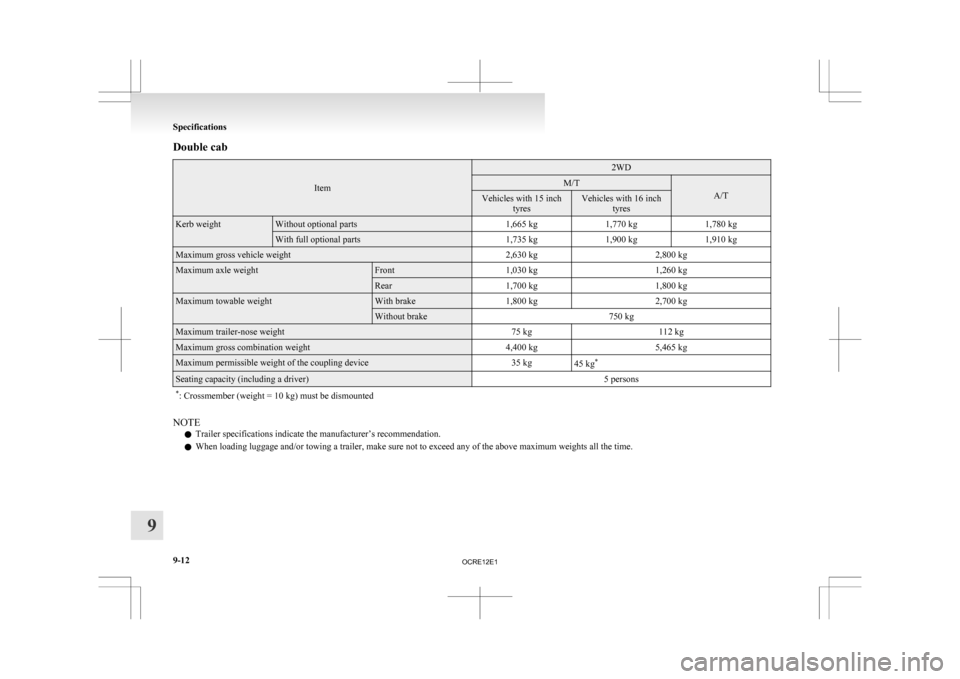
Double cab
Item 2WD
M/T
A/T
Vehicles with 15 inch
tyres Vehicles with 16 inch
tyres Kerb weight Without optional parts
1,665 kg1,770 kg1,780 kg With full optional parts
1,735 kg1,900 kg1,910 kgMaximum gross vehicle weight
2,630 kg2,800 kgMaximum axle weight Front
1,030 kg 1,260 kg Rear
1,700 kg 1,800 kgMaximum towable weight With brake
1,800 kg 2,700 kg Without brake
750 kgMaximum trailer-nose weight
75 kg112 kgMaximum gross combination weight
4,400 kg5,465 kgMaximum permissible weight of the coupling device
35 kg
45 kg* Seating capacity (including a driver)
5 persons
* : Crossmember (weight = 10 kg) must be dismounted NOTE
l Trailer specifications indicate the manufacturer’s recommendation.
l When loading luggage and/or towing a trailer, make sure not to exceed any of the above maximum weights all the time. Specifications
9-12
9
OCRE12E1